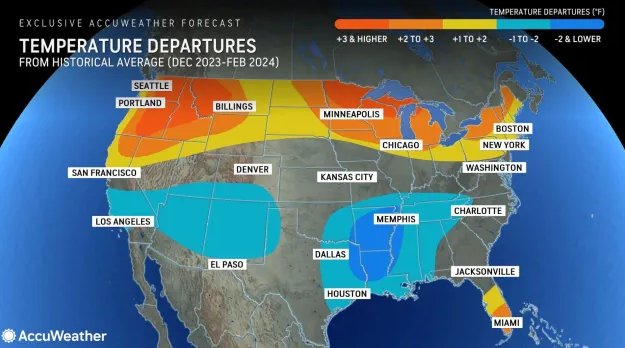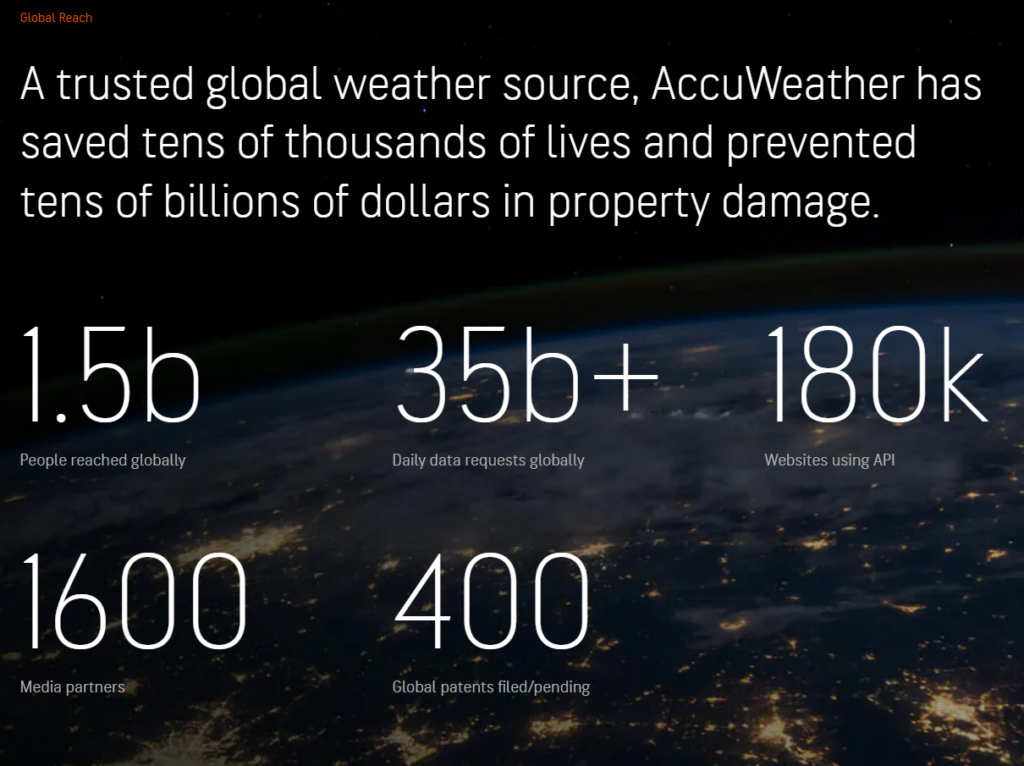Today’s Forecast: A High of AccuWeather Leveraging Data in their Forecasting, a Low of Dealing with Climate Change

Understanding how AccuWeather leverages data to provide the most accurate weather forecasts on the market.
AccuWeather is a weather forecasting company that utilizes their extensive data sets with advanced analytics to generate the most accurate weather forecasts on the market. The company then leverages their platform of APIs, websites, and mobile applications to make those forecasts available to consumers and businesses.
Live Forecast: https://www.accuweather.com/en/videos/accuweather-now/
Many sectors benefit from more advanced weather forecasting. Manufacturing and transportation need to know about severe inclement weather to determine if it’s safe to operate or if they need to pause operations and evacuate. Healthcare uses this information to adjust staffing, ensuring enough doctors and nurses are available to respond in case of emergency. Energy utilizes these forecasts to understand expected outages to their supply and develop strategies to mitigate the impact through weatherizing equipment. Finally, consumers benefit in from choosing their outfit of the day to planning vacations to being alerted of severe weather warnings and being advised to seek shelter.
According to the National Oceanic and Atmospheric Administration (NOAA), the U.S. has sustained 308 weather and climate disasters since 1980, causing damages/costs that have reached or exceeded $1 billion (source). With climate change increasing the frequency of these severe weather events, accurate forecasting is becoming even more important.
AccuWeather acts as a data aggregator, sourcing weather data from governments and partners; observations from land, ships, and aircraft; crowdsourced reports; satellites; and radar sets from 40 countries. The sensor arrays at these various observation points transmit their data in real-time, allowing for the most up to date information available. AccuWeather then processes that data using a combination of proprietary AI algorithms and meteorologists in what they call their “Digital Forecasting System.” An example of a proprietary forecast is their apparent temperature known as “RealFeel,” which incorporates temperature, wind, humidity, sunshine intensity, cloudiness, precipitation, and elevation to determine the equivalent temperature experienced by the human body (source). This is a patented measurement owned by AccuWeather (List of AccuWeather Patents)
Their forecasts are extensive, covering 2.3 million locations with 100+ different parameters. With 1.5B users around the world, AccuWeather translates this information into 200+ different languages and dialects. AccuWeather improves the accuracy of their models through several methods. First, they have a team of experienced meteorologists that sanity check the results. Second, it’s easy to observe the actual weather. A typical forecast operates on an hourly to 10-day range so, it’s straightforward to determine the ground truth and score their models. More details on their processes can be found here.
AccuWeather faced multiple challenges setting up their processes. First, they needed to partner with a significant number of governments and other agencies to source their input data. Since they operate globally, they need to gather data from around the world and not just a single source. They also needed to set up the infrastructure to support real-time data feeds.
Going forward, the biggest challenge they’re going to face is climate change. As global temperatures rise, backward looking models may no longer be the best predictors of future weather patterns. Current weather conditions will require models to extrapolate outside the range of their training data, potentially impacting accuracy.
AccuWeather captures value through several methods. First, they sell their forecasts to businesses that display this information for their own customers in a B2B2C model, which includes TV Networks, digital displays outside buildings (such as airports), audio broadcasts, and more. AccuWeather makes this information available through an API that allows customers to pull data and integrate it into their own solutions for rapid customization. The graphic below summarizes just how extensively AccuWeather’s data is being leveraged daily.
Source: https://corporate.accuweather.com/
AccuWeather has a website and mobile apps. The website and free versions of these apps include ads that AccuWeather claims, “can customize [their] advertising solutions to reach consumers when they are most receptive across any platform.” They likely generate revenue in a pay per click or per impression model, depending on how strong their conversion metrics are. In addition, the mobile apps offer two paid tiers: 1). Premium, which is ad-free for $1.99/month and 2). Premium+, which is ad-free and includes additional content such as: alerts, widgets for home & lock screens, and health outlooks, for $3.99/month. While the advertising revenue helps ensure a free version is available to anyone who needs an accurate weather forecast, recent app reviews have been more negative with users highlighting that an increase in ad traffic has degraded the experience. This showcases how difficult it can be to monetize a service that consumers expect for free.






Hi Ben- great blog. I was one of the people complaining about the crazy uptick in ads on AccuWeather’s app. Unfortunately it got so bad I deleted it :/ I feel like these days there are lots of sources from which people can get weather data. For instance, I just use the weather app info that comes with my iPhone (not sure if Apple is one of the B2B companies that partners with AccuWeather in the backend). Given competition, do you think AccuWeather has strong enough differentiation to remain a key player? Also, what do you think is next for them to consider adding to their product moving forward?
Hi Ben – this was a great read! It was good to get some exposure to how weather forecast companies try to meet customers’ needs. In general I view weather companies as offering a commodity product, so it’s interesting to see how the company has tried to differentiate – I would also be curious to know if they have any partnerships to provide their service for the non-consumer sectors you referenced. One open question to help me better understand its move away from commoditization is: do you think their investments in data analytics and the “realfeel” feature is something that is just simply required for them to keep up with competition (has competition also made the same level of data bets as Accuweather)?
This is an awesome article, Ben! I was wondering what your thoughts are on AccuWeathers next move given the change in user behavior with the onset of tools like ChatGPT. For instance, users have become (or are becoming) accustomed to getting exactly the information they need. Does Accuweather need to change its approach to giving people actionable insights rather than just raw data? For example, as a user, the most important information to me is not that the temperature is 32 degrees and about to rain, it’s that I need to wear a sweater and carry an umbrella. How would the product, interface and information architecture need to change? Will the change in product structure attract more customers similar to how ChatGPT has attracted customers who used to go to Google.
Wow, I didn’t realize the sophistication behind AccuWeather’s forecasts! I always thought they were “yet another measurement platform” , and I’m impressed that they were able to negotiate so many contracts with non-traditional weather groups to get a final estimate. I can imagine that they are leveraging the “wisdom of the crowd” to get a more accurate reading, but it would also be cool to see just how much more accurate they are than other sources, and that when they are wrong, is it only because they are seeing historically unprecedented events (ex. global warming related surges), or is it that there are consistent blind spots when it comes to humans measuring weather. I also wonder if this system of gathering such a varied dataset and collating it into a single graph has other uses as well, such as tracking the spread of disease vectors.
Thank for this amazing post Ben! I am a long-time AccuWeather user and I have always been wondering how it does weather forecasting so well that in my opinion, no-one else could compete with it. Now it all makes sense that they are a large group of experts who work on an immerse amount of data to provide the best models. I am also intrigued by your mentioning of their biggest challenge beign the climate change, which really makes sense as climate change is something that is hard to predict (or maybe there is a way they can predict climate change and incoporate that into their models?). If I were given a chance, I really would love to see how it actually collects, stores, and cleans, and utilizes data exactly.
Great article, Ben! It’s fascinating to see how AccuWeather uses a mix of advanced analytics and real-time data to provide accurate forecasts.
I’m curious about the applicability of their model to other markets. Weather forecasting is one of those fields where being wrong isn’t necessarily too costly, at least in the short term. People might carry an umbrella when they don’t need to, but that’s about it for the average consumer. This makes me wonder if AccuWeather’s model could be replicable in other markets where the cost of a wrong prediction could be much higher. For example, could their approach be adapted for financial markets or healthcare predictions, where the stakes are significantly greater?
Given that AccuWeather has managed to create a robust model for weather prediction, it would be interesting to see if their methods could be applied in other sectors that also rely heavily on predictive analytics.